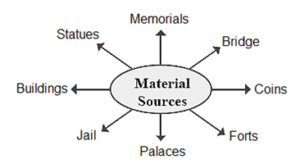Question 1. Rewrite the statements by choosing the appropriate options.
(1) Among the historical sources ...............sources are based on Modern technology.
(a) Written
(b) Oral
(c) Material
(d) Audio-visual
(2) The ............... is a museum in Pune which gives information about the history of Mahatma Gandhi.
(a) Aga Khan Palace
(b) Sabarmati Ashram
(c) Cellular Jail
(d) Lakshmi Vilas Palace
(3) A unique discovery of modern technology in 20th century is .......... .
(a) Powada
(b) Photograph
(c) Interviews
(d) Films
Question 2. Explain the following statements with reasons.
(1) During the British period newspapers also acted as source of social reformation.
Answer :
- In the pre independence period, newspapers like Dnyanoday, Dnyanprakash, Amrit Bazaar Patrika, Deenbandhu, Kesari acted as important source of awakening the minds of the people.
- The ‘Nibandhmala’ by Vishnushastri Chiplunkar and Shatapatre written by Lokahitawadi in the weekly ‘Prabhakar’ commented on various social and cultural issues.
- Newspapers in the British period not only opposed imperialism but also educated the masses and created awareness among the people.
- In April 1927, Dr. Ambedkar started the newspaper ‘Bahishkrut Bharat’. Through the medium of Bahishkrut Bharat he wrote for the reformation of common people and brings unity among them.
- Newspapers threw light on ill customs like sati, child marriage, ban on widow remarriage, etc. and awakened minds of the people.
- We came to know about various policies of the British towards India and their effects on India.
- Thus newspapers were not only source of political events but also acted as a source of social reformation.
(2) Audio Visual Recordings are considered as the most trustworthy source for the study of Modern Indian History.
Answer :
Audio-visual recordings are considered as trustworthy source for study of modern history. Because —
- Important events during the freedom struggle could be seen in reality.
- Audio-visual recordings of Dandi March, Quit India movement, Salt Satyagraha and other historical events are available. Through these films the events could be seen in reality.
- Films also dealt with subjects like social problems, superstitions, practices. They represent current social, religious, and political problems.
Therefore, audio-visual recordings are considered as a unique discovery of 20th century.
Question 3. Write short notes.
(1) Photographs
Answer :
- From the photographs we get information of the person or an event in a visual format. The photograph of an object or structure helps in understanding its nature.
- Paintings were a significant historical source before photography was created. But the authenticity of such paintings is doubtful.
- Photographs are considered more reliable, as the lens capture the persons events and objects exactly as they appear
- The photograph of a person gives information about the physical features dressing style, etc.
- Hence, photographs are important visual source of modern Indian history.
(2) Museums and History
Answer :
- A museum is a location where historic objects, such as paintings, pictures, tools, coins, clothing, and art, are kept and displayed for historical research.
- Ancient artefacts provide insight on the economic, social, political, and religious aspects of the time period.
- The metal and inscriptions on the coin provide information about the economic conditions of the time and the metals used.
- We learn about advancements in the arts of tool making, painting, sculpting, and metallurgy.
- Museums and history are linked. They are major source of writing history.
(3) Audio sources
Answer :
- Recording is a form of audio source in history.
- The discovery of technique of recording was very important.
- Akashvani, audio tapes are considered important audio sources.
- Jana Gana Mana sung by Rabindranath Tagore, speeches of Subash Chandra Bose, Mahatma Gandhi, speeches of leaders and personalities are broadcast from Akashvani.
- We get to know about prevalent social, cultural, intellectual and educational history of a particular period from audio
Question 4. Complete the following diagram.


